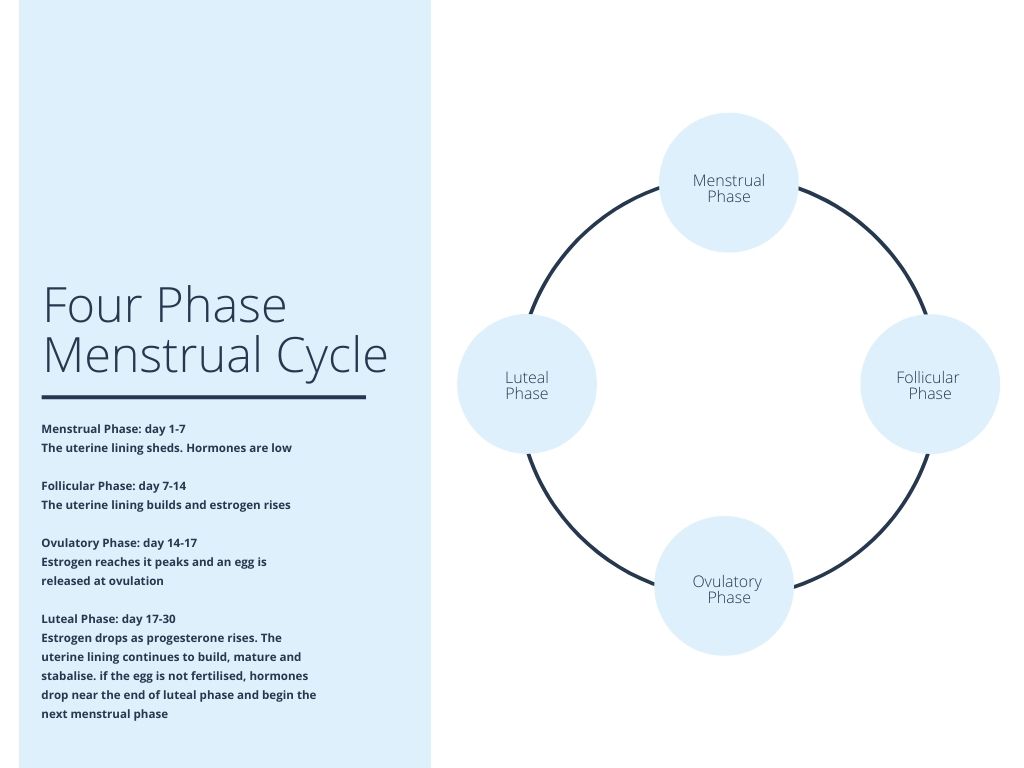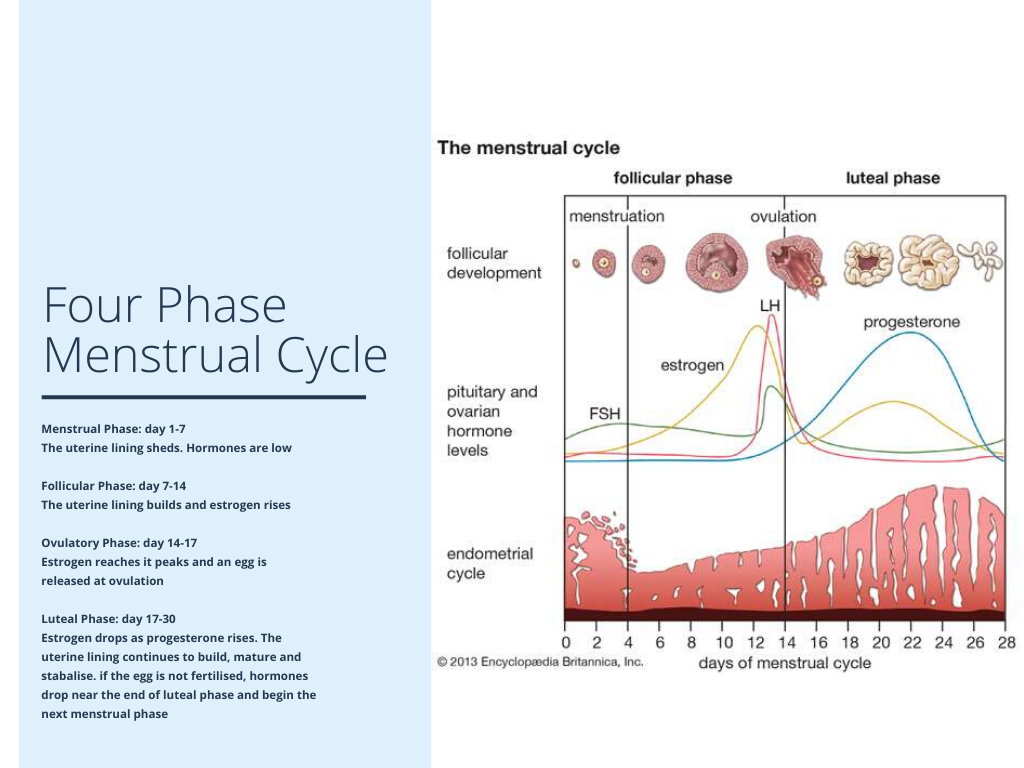As I dive deeper into the hormone space, I want to write more and more articles around hormone health and balancing, but it is hard to do so when there is a general lack of education around how the female body works. This post is intended to help educate cycling women about the hormonal changes that happen throughout the month. Understanding the menstrual cycle is important not only to assist with pregnancy or to avoid pregnancy but also to understand how our emotions, cognition, and nutritional needs change throughout the month. The very first line of my university lecture on the female reproductive system said this “the main difference between men and women is that women are cyclical” Understanding how the menstrual cycle works can help women work with their bodies instead of against them.
The onset of menstruation generally occurs between the ages of 11-14. The average menstrual cycle lasts from 25-35 days and it differs for each woman. The length of the menstrual cycle is calculated from the first day of your period until the day before the next period arrives. Generally speaking, the menstrual cycle can be divided into four distinct phases: menstrual phase, follicular phase, ovulation, and luteal phase. Each phase is regulated by hormones that perform similar but different roles. Women will continue to have cycles until menopause which usually occurs at around age 50.
Menstrual Phase:
The menstrual phase, also known as “winter” is the first stage of the menstrual cycle and is characterised by bleeding. Bleeding occurs because the egg from the previous cycle was not fertilised so the uterus sheds its lining. During this time a combination of blood, tissue, and mucous is expelled from the uterus. The average length of bleeding is 3-7 days. At this stage, hormones are at their lowest point during the month. This also means that energy is usually at its lowest point during and our behaviour is more introverted and inward-focused. At this time of the month, the left and right hemisphere work together more than at any other time of the month, making it an ideal time to plan.
Follicular Phase:
The follicular phase, also known as the proliferative phase or “spring” encompasses both menstruation and the period of time between menstruation and ovulation. During this time the hypothalamus in the brain sends signals to the pituitary to release a hormone called follicle-stimulating hormone or FSH. FSH causes an average of 5-20 different follicles (fluid-filled sacs) in the ovary to develop. Each follicle houses an immature egg. These follicles grow and develop and secrete estrogen, more specifically a type of estrogen called estradiol. Estrogen rises during the follicular phase and helps to build the uterine lining in preparation for a potential pregnancy. Only one of the eggs will completely mature and be chosen for ovulation in the next phase, the rest will die. The phase is characterised by rising estrogen and an increase in cervical mucus production and a change in cervical mucus consistency (changes from dry to creamy to wet and slippery as estrogen increases). The follicular phase is an estrogen dominant phase. Beyond reproduction, estrogen is responsible for breast development, bone formation, maintaining the integrity and lubrication of the vagina, and has roles in many other bodily functions including muscle development, skin, hair, and mucosal membranes. Estrogen is strongly linked with the neurotransmitter serotonin which is associated with good mood and feelings of happiness. It is also a regulatory factor for noradrenaline and dopamine which are also responsible for mood. During this phase, appetite is lower, moods are usually more stable, and “happy” energy and athletic performance increase, memory and creativity improves and there is an increased desire to socialise.
Ovulatory Phase:
The ovulatory phase, also known as summer is the period of time when the mature egg is released from the ovary. The egg is funnelled through the fallopian tube towards the uterus. The egg only survives for 12- 24 before it dies unless it is fertilised by sperm. Ovulation usually occurs mid-cycle, or around day 12-16, however, the timing of ovulation can change from month to month depending on different circumstances. The length of the menstrual cycle is dictated by the timing of ovulation. As levels of estrogen rise during the follicular phase, the hypothalamus detects this and signals the release of gonadotropin-releasing hormone which in turn signals the pituitary to release luteinising hormone (LH) and more FSH. This signals the egg to release. Estrogen will reach is peak level just prior to ovulation. Testosterone also increases just before ovulation which will increase libido and energy. Once ovulation has occurred, estrogen begins to drop drastically and progesterone begins to rise. Ovulation is usually characterised by an increase in libido, high energy, and increased social and cognitive abilities. It is also the most selfless time of the month when women are wired to do things for other people.
Luteal phase:
The luteal phase is also known as the secretory phase or “autumn.” The luteal phase occurs from ovulation until the day before the next period arrives. The length of the luteal phase is usually 10-16 days and remains fixed unless a hormonal imbalance arises. Once the egg is released at ovulation the ruptured follicle remains on the ovary surface and turns into a structure known as the “corpus luteum.” This structure produces a large amount of progesterone and a little bit of estrogen. No progesterone is produced from the ovary if there is no ovulation. Progesterone is responsible for maturing the uterine lining in preparation for pregnancy. It also helps to counterbalance the effects of estrogen. During this stage cervical mucus becomes dry and tacky and pregnancy can no longer occur. During the later part of the luteal phase, estrogen begins to rise again slightly before both estrogen and progesterone drop off abruptly signaling the start of the next menstrual cycle if pregnancy has not occurred. The luteal phase is a progesterone dominant phase. Progesterone is responsible for bone and muscle development, blood sugar regulation, skin, hair, and nails. Progesterone is strongly associated with the neurotransmitter GABA. GABA and progesterone help to induce a feeling of calm. During this phase appetite increases, behaviour becomes more introverted, the brain becomes more detailed orientated and task-focused. Energy and athletic performance slowly decrease throughout the phase, especially in the latter part of the phase. If there is excess estrogen or inadequate progesterone it is also common for PMS symptoms to occur during this phase.

The above information only relates to cycling women with regular periods and regular ovulation. It does not apply to women on hormonal birth control which suppresses ovulation and therefore suppresses hormone production. Similarly, if periods are irregular or missing due to various reasons eg. hormonal imbalance or breastfeeding the above information is only partially useful. I encourage every woman to study the graphs of the menstrual cycle and to learn the physical symptoms associated with the hormones secreted at different times of the month. It took me a long time to understand this process and I remember staring at charts for a long period of time before I understood what was really going on, but although it may seem complex at first, it is simple once you understand the process. Women deserve to know how their bodies work. They deserve this knowledge to take control of their own health. Understanding the mensural cycle is one of the best ways to identify potential hormonal imbalances and is vital information for all women of reproductive age. Understanding the menstrual cycle is also key to living life to our fullest as women, and helps to increase productivity and energy and provide a structure and routine that works for our bodies. Honouring the different phases of the menstrual cycle and planning life around them is also instrumental in helping to avoid potential hormone imbalances in the future.
For an in depth understanding of the menstrual cycle, consider looking into learning the fertility awareness method. You can read more about it here https://talidavoinea.au/what-is-fertility-awareness-method-and-what-is-it-used-for/










